- Home
- Quizzes
- My Quiz Activity
- Newsletters
- Sports Betting
- MY FAVORITES
- Add Sports/Teams
- SPORTS
-
NFL
- NFL Home
- Arizona Cardinals
- Atlanta Falcons
- Baltimore Ravens
- Buffalo Bills
- Carolina Panthers
- Chicago Bears
- Cincinnati Bengals
- Cleveland Browns
- Dallas Cowboys
- Denver Broncos
- Detroit Lions
- Green Bay Packers
- Houston Texans
- Indianapolis Colts
- Jacksonville Jaguars
- Kansas City Chiefs
- Las Vegas Raiders
- Los Angeles Chargers
- Los Angeles Rams
- Miami Dolphins
- Minnesota Vikings
- New England Patriots
- New Orleans Saints
- New York Jets
- New York Giants
- Philadelphia Eagles
- Pittsburgh Steelers
- San Francisco 49ers
- Seattle Seahawks
- Tampa Bay Buccaneers
- Tennessee Titans
- Washington Commanders
-
MLB
- MLB Home
- Arizona Diamondbacks
- Atlanta Braves
- Baltimore Orioles
- Boston Red Sox
- Chicago White Sox
- Chicago Cubs
- Cincinnati Reds
- Cleveland Guardians
- Colorado Rockies
- Detroit Tigers
- Houston Astros
- Kansas City Royals
- Los Angeles Angels
- Los Angeles Dodgers
- Miami Marlins
- Milwaukee Brewers
- Minnesota Twins
- New York Yankees
- New York Mets
- Oakland Athletics
- Philadelphia Phillies
- Pittsburgh Pirates
- San Diego Padres
- San Francisco Giants
- Seattle Mariners
- St. Louis Cardinals
- Tampa Bay Rays
- Texas Rangers
- Toronto Blue Jays
- Washington Nationals
-
NBA
- NBA Home
- Atlanta Hawks
- Boston Celtics
- Brooklyn Nets
- Charlotte Hornets
- Chicago Bulls
- Cleveland Cavaliers
- Dallas Mavericks
- Denver Nuggets
- Detroit Pistons
- Golden State Warriors
- Houston Rockets
- Indiana Pacers
- Los Angeles Clippers
- Los Angeles Lakers
- Memphis Grizzlies
- Miami Heat
- Milwaukee Bucks
- Minnesota Timberwolves
- New Orleans Pelicans
- New York Knicks
- Oklahoma City Thunder
- Orlando Magic
- Philadelphia 76ers
- Phoenix Suns
- Portland Trail Blazers
- Sacramento Kings
- San Antonio Spurs
- Toronto Raptors
- Utah Jazz
- Washington Wizards
-
NHL
- NHL Home
- Anaheim Ducks
- Boston Bruins
- Buffalo Sabres
- Calgary Flames
- Carolina Hurricanes
- Chicago Blackhawks
- Colorado Avalanche
- Columbus Blue Jackets
- Dallas Stars
- Detroit Red Wings
- Edmonton Oilers
- Florida Panthers
- Los Angeles Kings
- Minnesota Wild
- Montreal Canadiens
- Nashville Predators
- New Jersey Devils
- New York Islanders
- New York Rangers
- Ottawa Senators
- Philadelphia Flyers
- Pittsburgh Penguins
- San Jose Sharks
- Seattle Kraken
- St. Louis Blues
- Tampa Bay Lightning
- Toronto Maple Leafs
- Utah Hockey Club
- Vancouver Canucks
- Vegas Golden Knights
- Washington Capitals
- Winnipeg Jets
- NCAAF
- NCAAM
- Olympics
- Boxing
- Entertainment
- Lifestyle
- Golf
- MMA
- Soccer
- Tennis
- Wrestling
- More Sports
- RESOURCES
- My Account
- YB on Facebook
- YB on Twitter
- YB on Flipboard
- Contact Us
- Privacy Policy
- Terms of Service
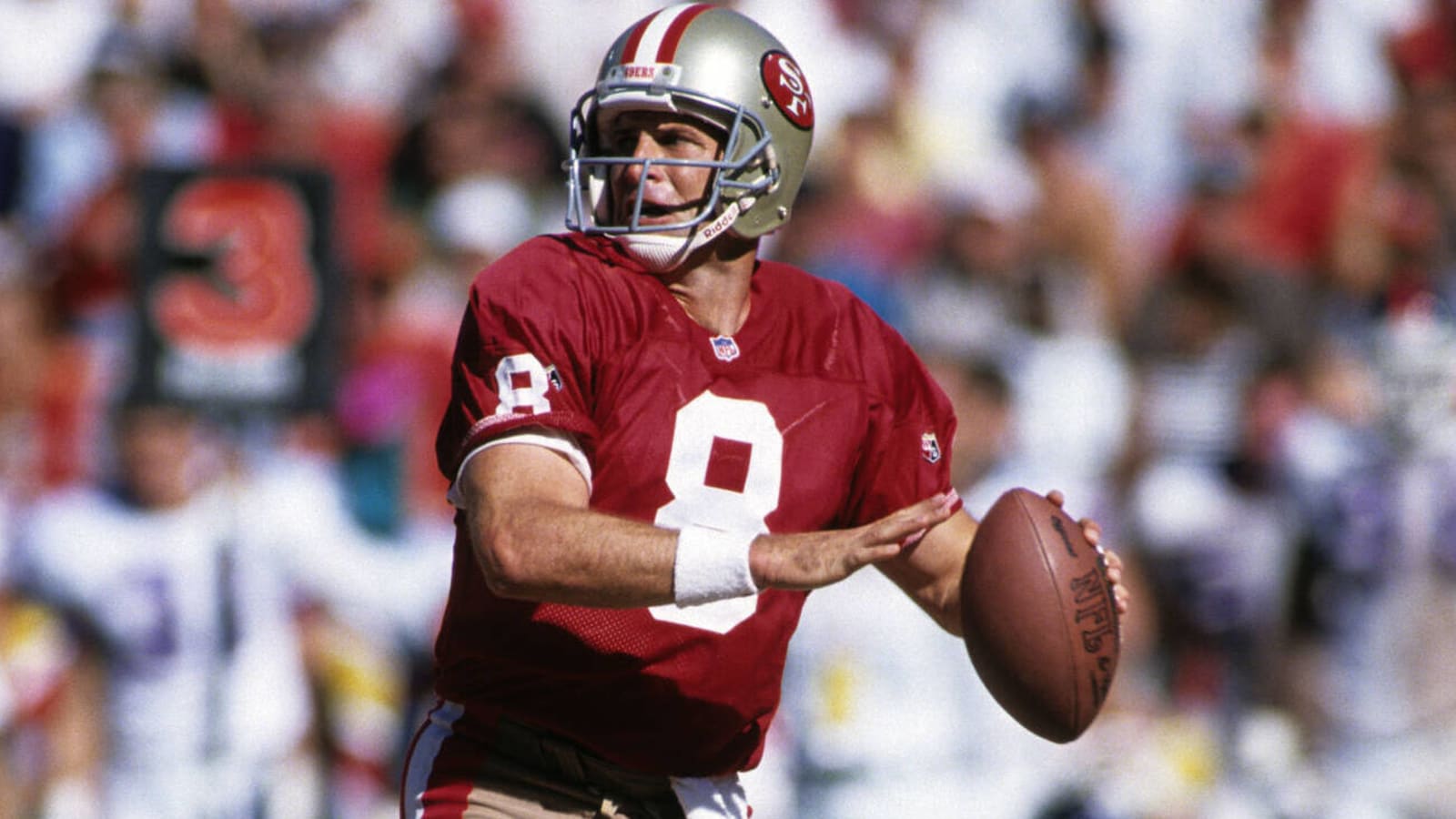
Steve Young: Career retrospective
August 13 is International Left-Handers Day. The holiday celebrates left-handers and all they’ve accomplished. Here at Yardbarker, we’re honored to bring you Steve Young’s career retrospective as a way to honor the occasion. Let’s take a look at the best moments from the greatest left-handed quarterback of all time.
Here’s to all the lefties out there thriving and prospering!
Three-sport high school athlete

Steve Young grew up in his hometown of Salt Lake City, Utah, until his family moved to Greenwich, Connecticut, when he was eight. At Greenwich High School, Young made a name for himself, becoming a standout athlete for the football, basketball, and baseball teams. In football, Young manned a run-heavy read option offense, winning Connecticut Interscholastic Athletic Conference (CIAC) All-State honors his senior year. The three-sport athlete became a living legend while playing for the Greenwich Cardinals.
Committing to BYU

During his high school career, Young had his way with the competition as a dual-threat quarterback. He was heavily recruited by the top football programs in the country. After much debate, Young committed to Brigham Young University.
Initially, the coaching staff at BYU wanted the natural athlete to switch to running back or defensive back to better fit his skill set. Young worked tirelessly every day to improve as a passer and eventually became the Cougar’s starting quarterback.
Fun fact: Young is the great-great-great-grandson of Brigham Young, who was an early leader of the Mormon Church and who the university is named after.
Sensational senior season

Young had the best season of his college career in 1983. The senior passed for 3,902 yards, 33 touchdowns to just 10 interceptions and a 71% completion percentage. On the ground, he ran for 444 yards and eight touchdowns. The BYU Cougars went 11-1 and won the Western Athletic Conference (WAC) championship. The Cougars beat the Missouri Tigers in the Holiday Bowl, 21-17.
For his sensational senior year, Young was named a Unanimous All-American and won the Davey O’Brien Award, which is given to the best college quarterback in the country. He finished second in voting for the Heisman Trophy.
Young finished his college career with 7,733 yards, 56 touchdowns, 33 interceptions and completed 65% of his passes. A threat with his legs, he also had 1,084 rushing yards and 18 touchdowns. The campus hero was enshrined into the College Football Hall of Fame as a member of the Class of 2001.
The USFL days

Instead of playing for the NFL, Young decided to sign with the Los Angeles Express on a ten-year, $40 million contract. Young was intrigued by the idea of starting right away in the USFL. In two seasons with the Express (1984-85), Young threw 4,102 yards, 16 touchdowns and 22 interceptions. He also ran for 883 yards and 9 touchdowns on 135 carries.
The USFL folded in 1986.
Drafted by the Tampa Bay Buccaneers
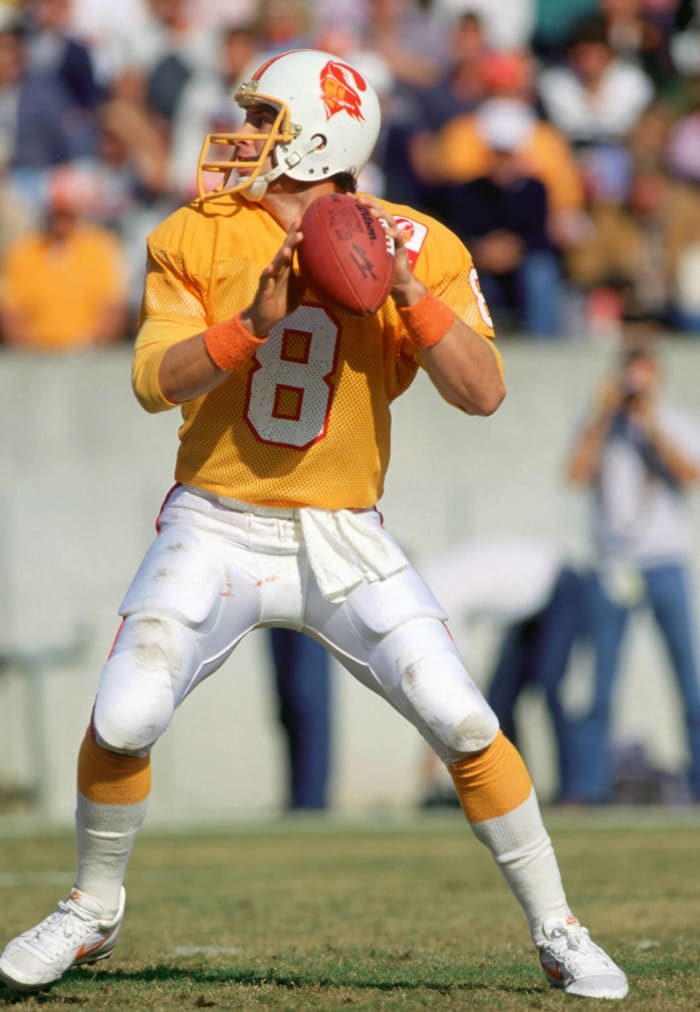
The Tampa Bay Buccaneers drafted Young first overall in the 1984 supplemental NFL Draft. After two years in the USFL, Young bought out his contract and signed with the Buccaneers in 1985. Since the USFL was a spring-summer league, Young could play for the Bucs in 1985.
Down and Out in Tampa Bay

In two seasons with Tampa Bay, Young compiled a 3-16 win-loss record, passed for 3,217 yards, 11 touchdowns and 21 interceptions. He was sacked 68 times and posted a 61.2 average passer rating. The Buccaneers were the cellar dwellers of the NFL. They had a losing record every year from 1983-1996. While Young struggled in Tampa Bay, the problem was within the organization, not his ability to perform at the next level.
Traded to the San Francisco 49ers
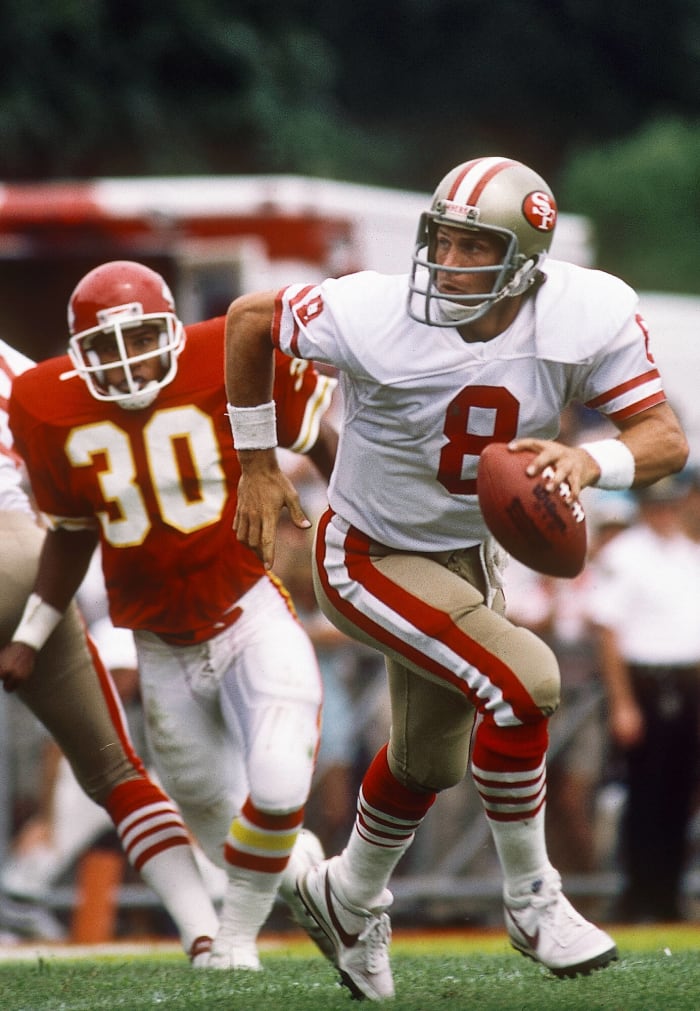
The Buccaneers drafted quarterback Vinny Testaverde with the first pick in the 1987 Draft. It signaled the end of Young’s time with Tampa Bay. His performance raised more questions than answers and he was written off as a bust. When it seemed the lights were going out on his professional career, the San Francisco 49ers came calling with a trade proposition. The 49ers gave up a second and fourth-round draft pick for Young.
Joe Montana's Backup
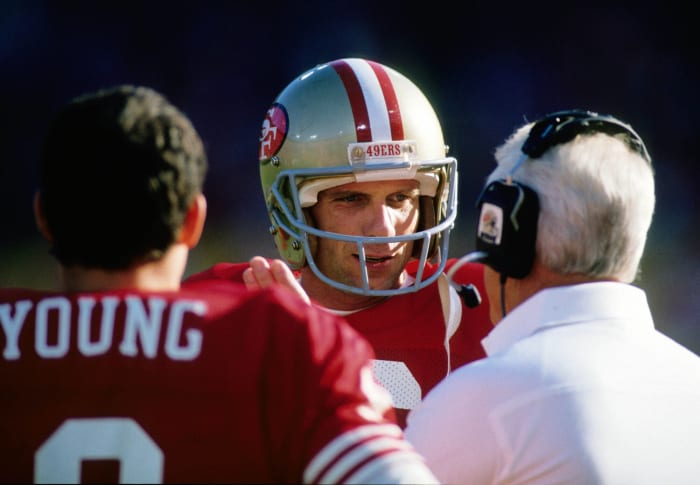
The left-handed kid from Utah got a fresh start with the San Francisco 49ers in 1987. Head coach Bill Walsh saw potential in the quarterback down on his luck. Young learned the fundamentals of the West Coast offense and was a backup to legendary quarterback Joe Montana.
A QB controversey in San Fran

Young wasn’t happy with his role and strived for an opportunity to prove himself. When he saw action in limited playing time, Young shined.
On October 30, 1988, he scored a 49-yard game-winning touchdown against the Vikings with 3:14 seconds left. It is one of the defining moments of his career. Overall, Young passed for 2,678 yards, 23 touchdowns and six interceptions while compiling a 7-3 win-loss record in the four years when he was the backup.
Young’s performance created a QB controversy in the Bay Area. The 49ers were Joe Montana’s team, no doubt. Joe was the best and Young came to take the throne.
It is often said iron sharpens iron. Both Montana and Young acted like professionals during the controversy and challenged each other to be great in every single practice. The 49ers won back-to-back Super Bowls (1988, 1989) during the controversy.
Young fills in for injured Joe Montana
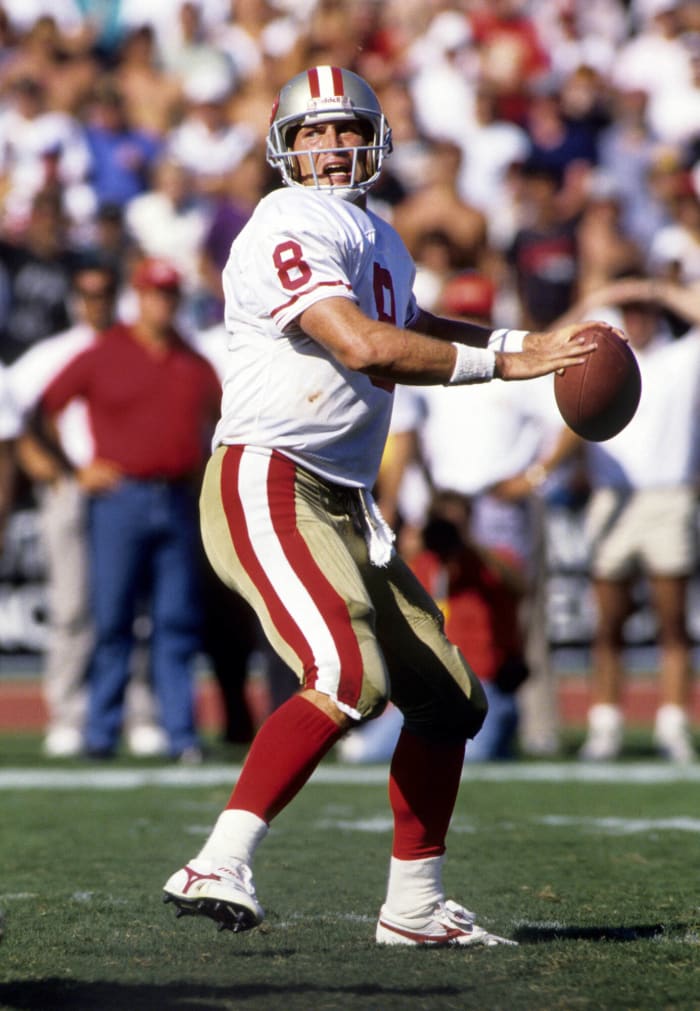
49ers legend Joe Montana suffered an elbow injury. He’d miss the entire 1991 season. Young capitalized on the moment, throwing for 2,517 yards, 17 touchdowns and a league-leading 101.8 passer rating. Despite going 10-6, the 49ers missed the playoffs in the stacked NFC. Regardless, it was the year that the 49ers transitioned from Montana to Young.
MVP season in 1992
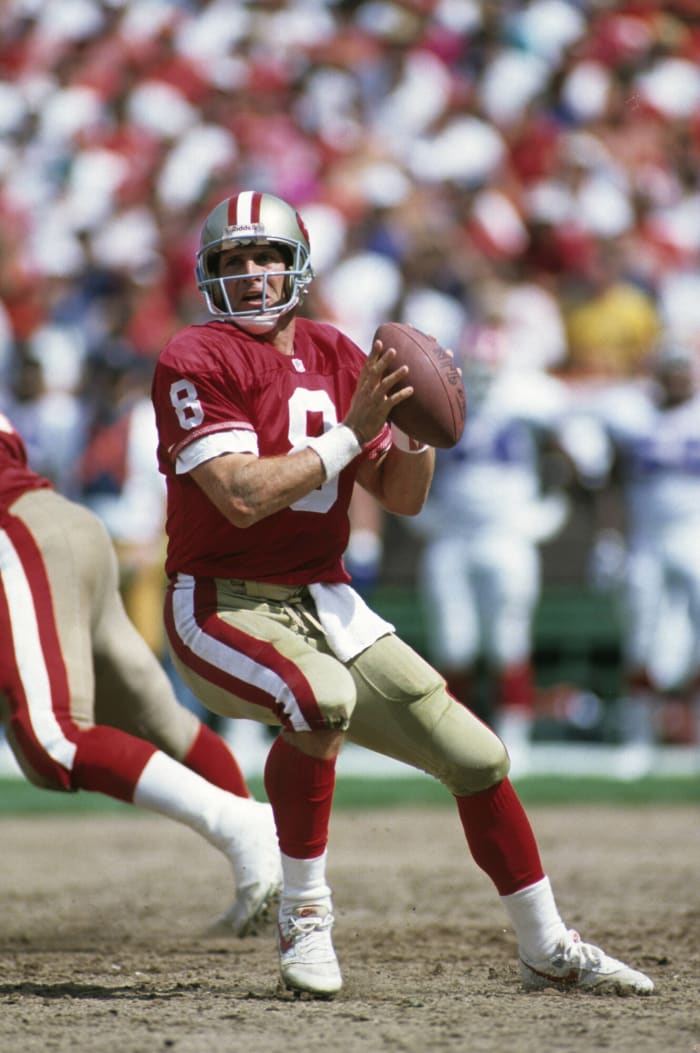
Young took over in 1992. He passed for 3,465 yards, 25 touchdowns, a 66.7% completion rate and a 107 passer rating. He also ran the ball 76 times for 537 yards and four touchdowns. Young won NFL MVP honors in his breakout season. The 49ers went 14-2 and were built for a deep playoff run.
Losing NFC Championship Game to Dallas Cowboys

In the playoffs, the 49ers defeated the Washington Commanders in a succinct 20-12 victory in the Divisional Round. They lost to the eventual Super Bowl champion Dallas Cowboys in the NFC Championship Game, 30-20. It was a tough ending to an otherwise positive year for the 49ers.
In the offseason, Joe Montana requested a trade to the Kansas City Chiefs, where he’d play the final two years of his career. Montana and Young played six years together.
1993 season ends in heartbreak

Young was a dynamic playmaker in 1993. He led the league in touchdowns (29) and passer rating (101.5). The 49ers went 10-6 and crushed the New York Giants in the divisional round, 44-3. They lost to the Dallas Cowboys again in the NFC Championship Game by a score of 38-21. The 49ers were Super Bowl contenders in the NFC. Their only problem was they couldn’t get past the Dallas Cowboys in the playoffs.
The playoff losses drew criticism toward Young, who had some serious shoes to fill succeeding Montana. The Bay Area still considered the 49ers Montana’s team. Some fans cheered for him and his new team, the Kansas City Chiefs. It wasn’t that the Bay Area didn’t like Young–he simply wasn’t Cool Joe. And the easiest way to silence the critics is by winning the Big Game. Until that happened, Montana’s shadow would hang over him.
Becoming a pocket passer

Young was a phenomenal running quarterback. It came with the territory of being a natural athlete. It also came with its risks. Scrambling was his first choice at times, and it would catch up with him. Young put in the work to become a good pocket passer. In his prime, Young only ran the ball as a last resort.
Winning second MVP
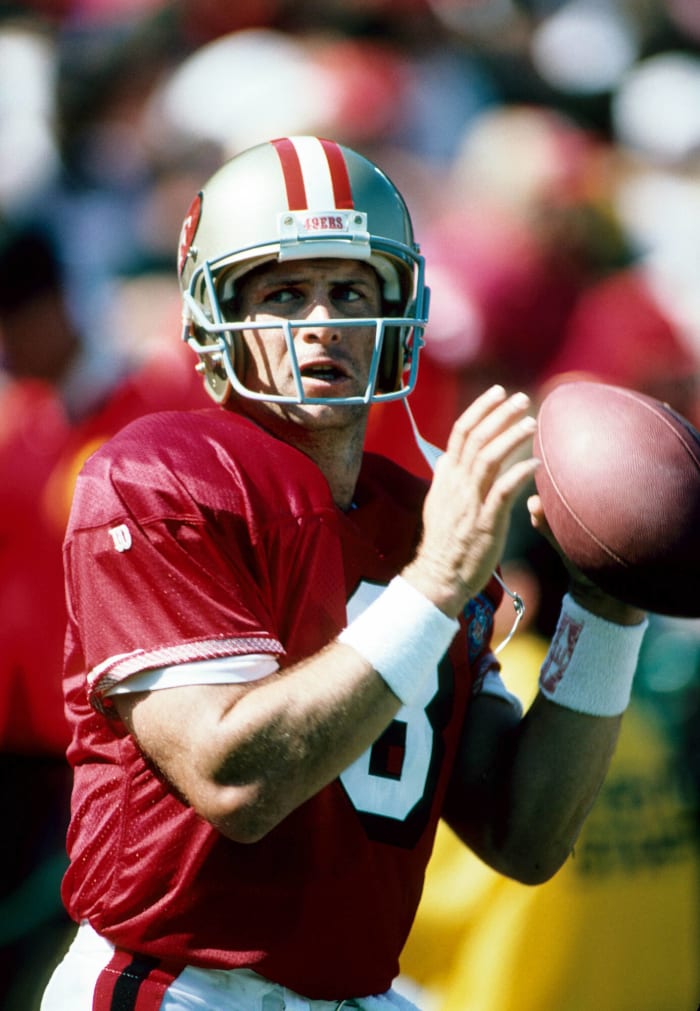
In 1994, Young threw for 3,969 yards and led the league in touchdowns (35), passer rating (112.8) and completion percentage (70.3). He led the 49ers to a 13-3 record. He also added 293 rushing yards and seven touchdowns on the ground. Young won MVP honors for his brilliant regular season.
Young lifts 49ers past Cowboys in playoffs

Determined to make a deep playoff run, the 49ers dominated the Chicago Bears in the Divisional Round, 44-15. In the NFC Conference Championship Game, the 49ers beat the Dallas Cowboys, 38-28. The 49ers finally beat the Cowboys! Young tossed two touchdowns and ran for one more in the victory.
Best Super Bowl performance ever?

The stage was set for Super Bowl XXIX. The San Francisco 49ers would versus the San Diego Chargers for football immortality. Young and the 49ers offense got rolling early and didn’t let up. Young tossed six passing touchdowns in the 49-26 blowout victory. For his remarkable effort, he was named Super Bowl MVP. His six touchdowns are a Super Bowl record. It was the best Super Bowl performance of all time.
It was official, Young had a ring of his own.
49ers face series of early playoff exits against Packers
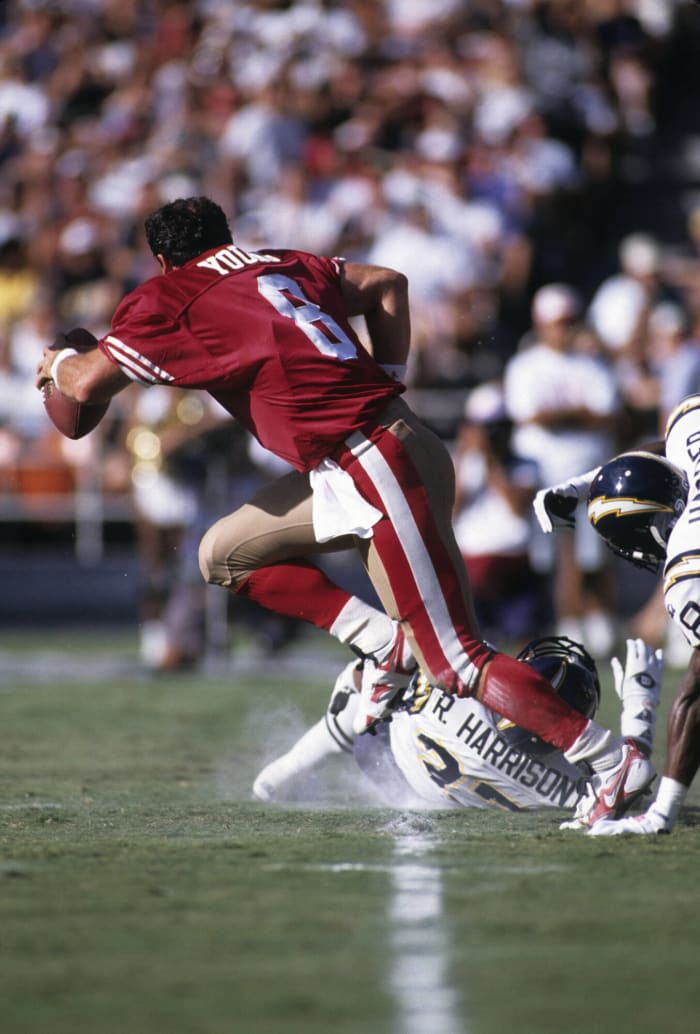
The 49ers were perennial contenders in the 90s. After winning Super Bowl XXIX, Young led his team to the playoffs three seasons in a row. Each year, they lost to the Green Bay Packers in the playoffs. From 1995-1998, he missed 10 games because of injury. His stats took a slight dip as well. The media started saying he was on his way out. Young had other plans.
The Catch II
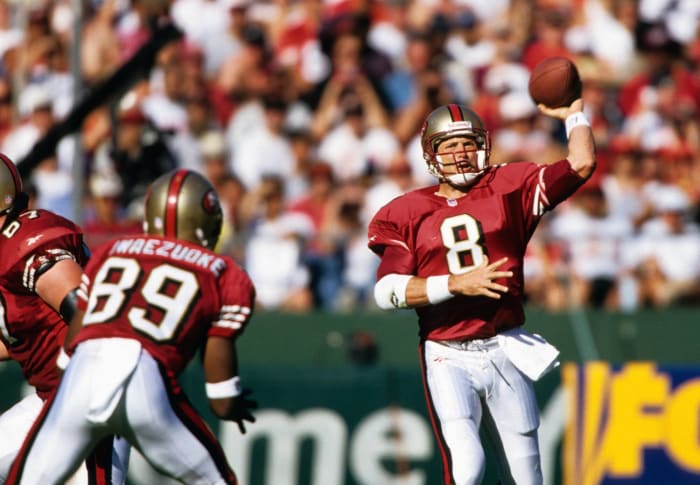
At 37, in his last full season in the NFL, Young passed for 4,170 yards and a league-leading 36 touchdowns. He rushed for 454 yards and six touchdowns. It was a career resurgence for the legendary quarterback.
The 49ers went 12-4 and faced the Packers in the Wild Card. In the fourth quarter, the 49ers were trailing 27-23 and Young was tasked with pulling the team to victory. With eight seconds left in the game, Young dropped back, stumbled, caught his composure and slung a pass into a tight window down the middle intended for Terrell Owens. Owens caught the ball and held on while being hit by defenders around him. It was a perfect throw. The 49ers beat the Packers and were advancing to the next round. The legendary play was nicknamed The Catch II. It pays homage to Joe Montana’s game-winning touchdown pass to Dwight Clark in the 1981 NFC Championship Game.
The 49ers lost 20-18 to the Atlanta Falcons in the Divisional Round. Young had three interceptions in the heartbreaking defeat.
Young's final season ends in injury
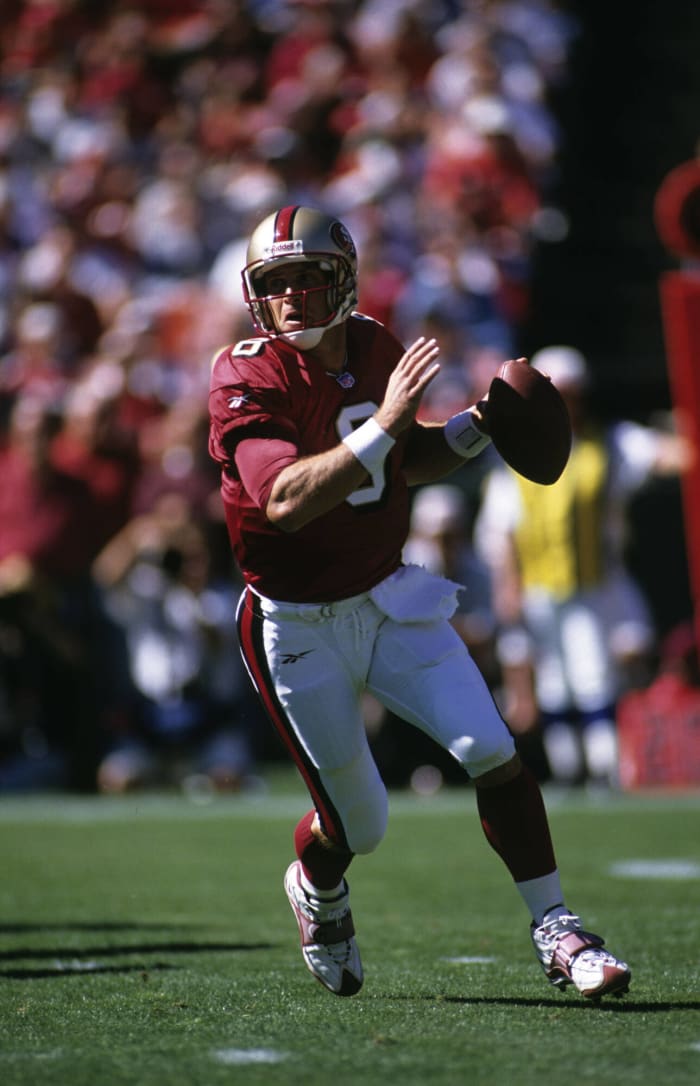
In week 3 during a Monday Night Football matchup against the Arizona Cardinals, Young was hit by Aeneas Williams on a cornerback blitz. The brutal hit gave Young a concussion. It was the seventh of his career. Young never suited up for another game.
Young passed for 446 yards, three touchdowns and four interceptions in his final season.
Retiring with highest career passer rating in NFL history
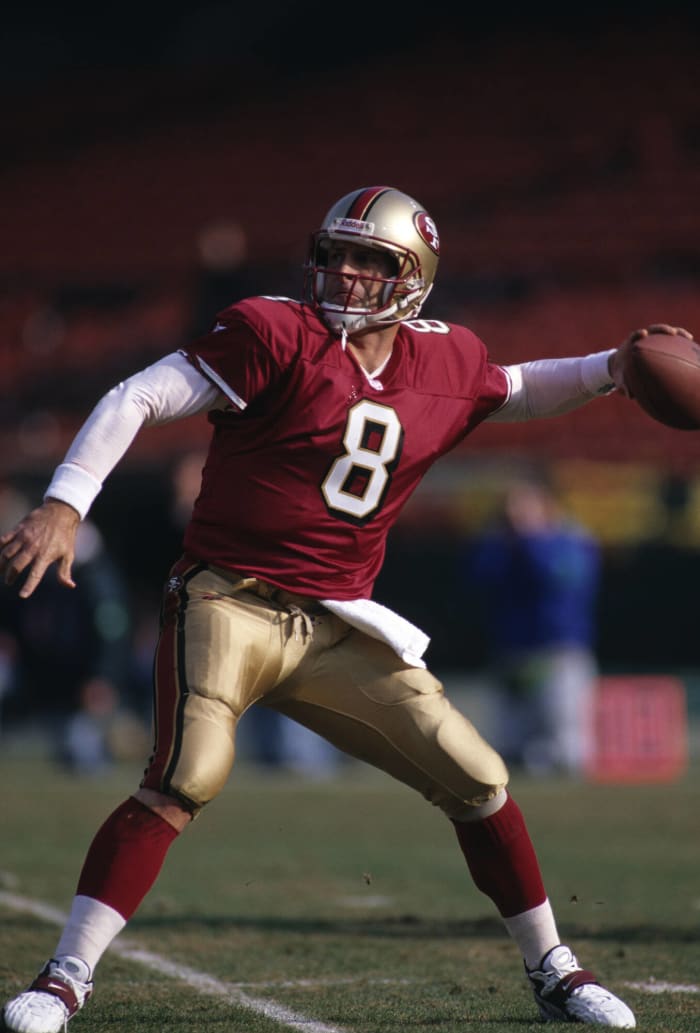
Young retired after the 1999 season. It was the right time to leave the game. He recently married his wife, Barbara Graham, and had just come off his seventh concussion. Young retired as the NFL’s all-time passer rating leader at 96.8. Currently, he is 10th all-time.
Young's trophy shelf

Young was a prolific passer. He led the league in passer rating six times, which is tied for most all-time with Sammy Baugh. He also led the league in passing touchdowns four times and completion percentage five times. A two-time NFL MVP, he won three Super Bowls. Two of those were as a backup and the last one was as the starter. He went to seven Pro Bowls and shattered the record books in the process. He holds the record for most rushing touchdowns in the postseason by a quarterback with eight.
Staying busy after football

The 49ers legend is just as interesting off the field. In 1994, he earned a Juris Doctor from BYU’s J. Reuben Clark Law School. He earned his law degree while balancing the tough schedule of being a professional football player. Young also co-founded Huntsman Gay Global Capital (HGGC), a private equity firm. Back to football, Young is an NFL analyst for ESPN.
Inducted into Hall of Fame
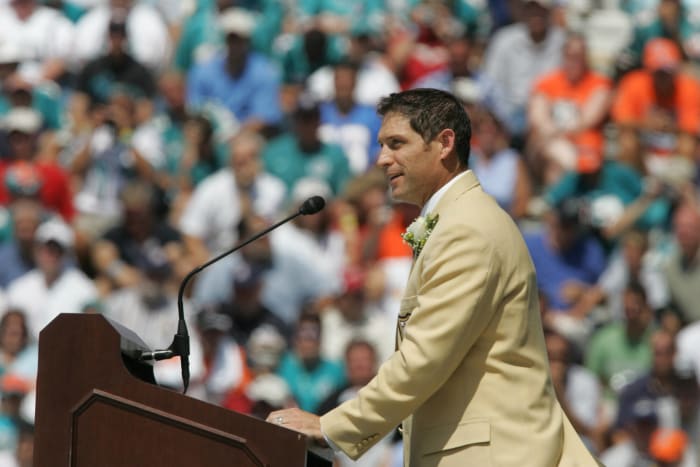
Young was inducted into the Pro Football Hall of Fame in 2005. It was a storybook ending to a storybook career. Ken Stabler and Young are the only left-handed quarterbacks in the Hall of Fame.
Over the course of his legendary career, Young held a 94-49 win-loss record, threw for 33,124 yards, 232 touchdowns, just 107 interceptions and posted a 64% completion percentage. Always a threat on the ground, he ran the ball 722 times for 4,239 yards and 43 touchdowns. He is fifth all-time in career rushing yards for a quarterback, according to StatMuse.
A left-handed legend
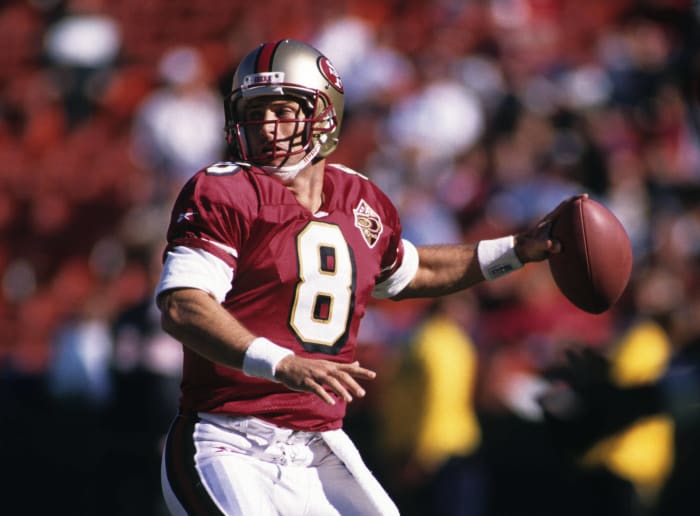
The quarterback everyone called a bust early on became the quarterback no one could stop. He fought against the odds and came out on top.
As a dual-threat, he could beat you by throwing or running. He was a great athlete who wasn’t afraid to break out of the pocket and scramble for the first down one play, and then throw a 50-yard bomb the next. Basically, the guy could do it all. He’s the greatest left-handed quarterback of all time, without a doubt.
David J. Hunt is a freelance writer based out of Philadelphia. He ran cross country at Penn State, became a volunteer firefighter during COVID-19, and is a self taught journalist. He's a diehard Philly sports fan. When he isn't watching sports, he enjoys working out, fishing, and traveling. You can find more of his writing at The Chestnut Hill Local and The Temple News. You can follow him on Twitter at @dave_hunt44.
More must-reads:
- Shannon Sharpe calls out Jets' Aaron Rodgers following loss to Patriots
- Commanders' Hail Mary a healing moment for Washington football
- The 'Multiple NFL games with 200 receiving yards' quiz
Breaking News
Customize Your Newsletter
 +
+
Get the latest news and rumors, customized to your favorite sports and teams. Emailed daily. Always free!
Use of this website (including any and all parts and
components) constitutes your acceptance of these
Terms of Service and Privacy Policy.
This site is for entertainment purposes only.
There is no gambling offered on this site.
Gambling Problem? Call 1-800-Gambler.
